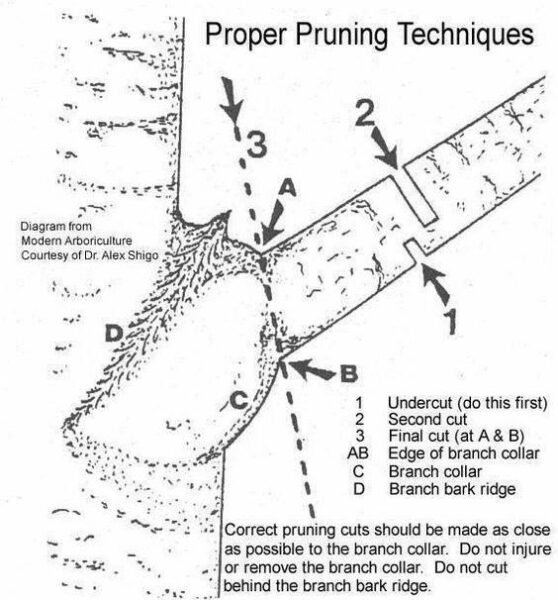Winter is a great, perhaps the best, time to prune your deciduous trees. During the winter, trees are in a dormant stage and nutrients and carbohydrates are stored in the wood and roots. No leaves will be in your way. If you wait till the leaves appear, these food sources will suffer as they have migrated to the leaves. The absence of leaves also helps you to see the tree’s form.
Pruning trees is both a science and an art. Depending on the tree’s location, use, and type, different pruning approaches will be necessary. Trees grow from the top, not the bottom. A branch at car door or waist level will not get higher as the tree grows, so a street tree (most often referring to a tree planted between the street and the sidewalk in a narrow strip of land) will likely need a different approach than one in your yard. Removal of dead branches keeps trees healthy. In a natural setting this happens on its own as branches fall without doing damage to houses and cars. In a neighborhood setting, be mindful of pedestrians and disabled community members. A tree that impedes access to the sidewalk or hits parked cars is going to suffer from self-help and risk branches that are torn off.
Too much pruning, however, will kill your trees. Trees need a canopy in the spring and summer to metabolize chlorophyl. Never prune your tree in one year more than 25%. Proper pruning will increase the health and longevity of your tree. It can also save it from destruction by making sure it does not become a hazard to pedestrians, power lines or traffic. If you are pruning evergreens, it is best to wait for late in their dormant season, usually the end of fall, early winter in central Maryland. Evergreens do not lose their needles like deciduous trees lose leaves. Instead, they produce an enzyme that acts like an antifreeze that protects the needles from freezing. Even evergreens can suffer harm if abnormally cold temperatures persist. If you are cutting greens for the holidays try and use a light touch spread over many trees to avoid harm.
Dead broken or diseased limbs as well as “water spouts” (tree branches that go straight up from the base or limbs) can be removed at any time. If limbs are crossing each other or rubbing against each other removal will not only open up the canopy but will minimize wind damage by creating better airflow.
Unless you have cars or pedestrian traffic right next to your tree, don’t let it look like a lollipop. It’s best to leave enough lower branches so that the wind can pass through the tree but not be likely to blow the tree over. In the woods and wilderness, trees lose their lower limbs due to competition and natural dying of the lower limbs. You want to imitate Mother Nature. Aim for radial symmetry when you prune. Late November through early March is the best time to prune. If you see eastern tent caterpillars on your trees in the early spring, it is ok to break up their webs without having to cut off their branches. If your trees suffer from fall web worm at the end of the summer, they are less likely to do any damage.

To avoid leaving gaping wounds or tears on your trees, use what’s known as the three-cut method for pruning. First, locate the collar- where the limb or branch attaches to the central leader or main branch. Make a small cut – a quarter to half way through the limb underneath the limb or branch you wish to remove, an inch or two away from its collar with the tree. Then cut the limb from the top about 2-3 inches away from the underneath cut. The undercut you just made will protect the limb from tearing off from the trunk as you complete your cut from the top. This avoids exposing it to damage and diseases. Your third cut is close to the collar as you remove the leftover stump where the limb or branch attaches to the trunk or main branch. Over time, this will callous over like a scar and protect the tree from infection or infestation. No treatment is needed to cover this cut. If you have a tree that needs pruning higher than you can reach, if possible, call a professional. If you keep your feet on the ground, you will keep the rest of you out of the hospital.
Carl R. Gold is a Maryland Master Naturalist, and a Treekeeper and Weed Warrior certified by the Baltimore City Arborist. He can be reached at cgold@carlgoldlaw.com.
